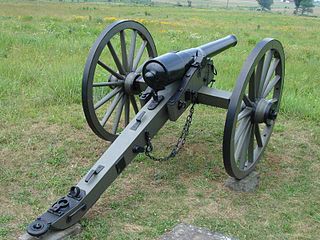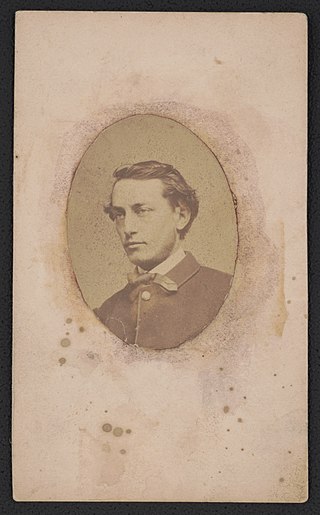Battery H, 1st Ohio Light Artillery was an artillery battery that served in the Union Army during the American Civil War. It was also known as Huntington's Battery.

Battery L, 1st Ohio Light Artillery was an artillery battery that served in the Union Army during the American Civil War.

The 66th Ohio Infantry Regiment was an infantry regiment in the Union Army during the American Civil War. It was noted for its holding the high ground at the center of the line at Antietam as part of Tyndale's 1st Brigade, Greene's 2nd Division of Mansfield's XII Corps.
5th Maine Light Artillery Battery was an artillery battery that served in the Union Army during the American Civil War.
Battery C, 1st Rhode Island Light Artillery Regiment was an artillery battery that served in the Union Army during the American Civil War.
Battery G, 1st Rhode Island Light Artillery Regiment was an artillery battery that served in the Union Army during the American Civil War.

Battery F, 1st Pennsylvania Light Artillery was a light artillery battery that served in the Union Army as part of the Pennsylvania Reserves infantry division during the American Civil War.

The 28th Pennsylvania Volunteer Infantry was an infantry regiment that served in the Union Army during the American Civil War. It was noted for its holding the high ground at the center of the line at Antietam as part of Tyndale's 1st Brigade, Greene's 2nd Division of Mansfield's XII Corps.
Battery L, 1st New York Light Artillery was an artillery battery that served in the Union Army during the American Civil War.
Battery "B", 4th Regiment of Artillery was a light artillery battery that served in the Union Army during the American Civil War.
Battery "C" 4th Regiment of Artillery was a light artillery battery that served in the Union Army during the American Civil War.
Battery "K" 5th Regiment of Artillery was a light artillery battery that served in the Union Army during the American Civil War.
The 5th Independent Battery, New York Volunteer Light Artillery or 5th New York Independent Light Artillery was an artillery battery that served in the Union Army during the American Civil War.
Battery "K" 1st Regiment of Artillery was a light artillery battery that served in the Union Army during the American Civil War.
The 29th Pennsylvania Volunteer Infantry was an infantry regiment that served in the Union Army during the American Civil War.

The 4th U.S. Artillery, Battery E was an artillery battery that served in the Union Army during the American Civil War. The unit fought at the battles of Kernstown, Port Republic, Rappahannock Station, Second Bull Run, Chantilly, Antietam, and Fredericksburg in 1862. The battery transferred to the Cavalry Corps where it served for the rest of the war. In 1863, 4th U.S. Artillery, Battery E fought at Chancellorsville, Gettysburg, Culpeper, Bristoe Station, and Mine Run. In 1864, the unit fought at the Wilderness, Todd's Tavern, Yellow Tavern, Totopotomoy, Cold Harbor, the Wilson-Kautz Raid, Opequon, Fisher's Hill, and Cedar Creek. In 1865, it saw action at Dinwiddie Court House, Five Forks, Sailor's Creek, and Appomattox before taking part in the Grand Review of the Armies.

Independent Battery E, Pennsylvania Light Artillery, was an artillery battery that served in the Union Army during the American Civil War. The unit organized in September 1861 from the elements of two infantry regiments and served until 14 June 1865. The battery participated in the battles of Cedar Mountain and Antietam in 1862 and Chancellorsville and Gettysburg in 1863. That fall, Battery E transferred to the Western theater where it fought in the battles of Wauhatchie, Lookout Mountain, Missionary Ridge, and Ringgold Gap. The years 1864–65 saw the unit take part in the Atlanta Campaign, Sherman's March to the Sea, and the battles of Averasborough and Bentonville. Battery E marched in the Grand Review of the Armies before being mustered out.

Independent Battery F, Pennsylvania Light Artillery, also known as the "Pittsburg Battery", was an artillery battery that served in the Union Army during the American Civil War. Organized in December 1861, the unit first served in the Shenandoah Valley. Battery F fought at Hancock, Winchester, Sulphur Springs, Second Bull Run, Chantilly, and Antietam in 1862. The following year the unit fought at Chancellorsville, Gettysburg, the Bristoe Campaign, and Mine Run. In 1864–1865, Battery F fought at Morton's Ford and served in the garrisons of Washington, D.C., and Harper's Ferry, West Virginia before being mustered out in June 1865. One enlisted man from the battery won the Medal of Honor for heroic action at Gettysburg.
Battery I, 1st New York Light Artillery Regiment was an artillery battery from New York state that served in the Union Army during the American Civil War. The battery was organized in October 1861. It fought at Cross Keys and Second Bull Run in 1862. Battery I fought at Chancellorsville, Gettysburg, and Chattanooga in 1863. It participated in the Atlanta campaign and Sherman's March to the Sea in 1864 and fought at Bentonville in 1865. The battery took part in the Grand Review of the Armies and was mustered out in June 1865.
13th Independent Battery New York Light Artillery was an artillery battery from New York state that served in the Union Army during the American Civil War. The battery was organized in October 1861. It fought at Cross Keys and Second Bull Run in 1862. The 13th Battery fought at Chancellorsville, Gettysburg, and Chattanooga in 1863. It participated in the Atlanta campaign and fought at Murfreesboro in 1864. The battery was on garrison duty in 1865 and was mustered out in July 1865.






